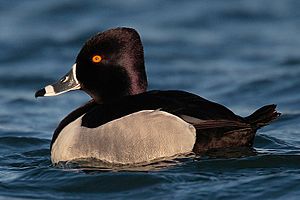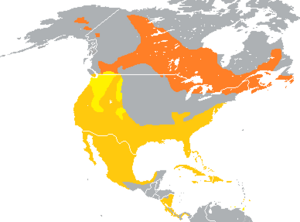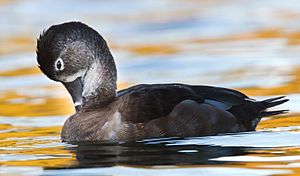Ring-necked duck facts for kids
Quick facts for kids Ring-necked duck |
|
|---|---|
 |
|
| Drake (male) | |
| Conservation status | |
| Scientific classification | |
| Genus: |
Aythya
|
| Species: |
collaris
|
 |
|
| Range of A. collaris Breeding range Year-round range Wintering range | |
The ring-necked duck (Aythya collaris) is a type of diving duck. You can often find these ducks in freshwater ponds and lakes across North America. Their scientific name comes from ancient Greek and Latin words. Aithuia was an old Greek word for a seabird, and collaris is Latin for "of the neck."
What They Look Like

Ring-necked ducks are small to medium-sized diving ducks. Here are some facts about their size:
- Length: They are usually about 15 to 18 inches (39-46 cm) long.
- Weight: They weigh between 17 and 32 ounces (490-910 grams).
- Wingspan: Their wings can spread about 24 to 25 inches (62-63 cm) wide.
Adult male ducks look a lot like their relatives, the Eurasian tufted ducks. Males are a bit bigger than females. They have a shiny black head and back, with two white rings on their gray bill. They also have a white line on their wings, a white chest, and bright yellow eyes.
Female ducks have a grayish-brown head and body with a dark brown back. Their bill is dark with a lighter band, but it's not as clear as the male's. Females have grayish-blue feet and brown eyes with white rings around them. They also make a sound like trrr.
The "ring" around their neck is usually hard to see. That's why some people call them "ringbills" instead, because the rings on their bill are much easier to spot!
Reproduction and Migration
Ring-necked ducks like to breed near wooded lakes or ponds. They mostly do this in the northern United States and Canada. Their main breeding area is in the Northwest boreal forests.
When winter comes, these ducks fly south. You can find them in southern North America in lakes, ponds, rivers, or bays.
Ring-necked duck pairs form during their spring migration. Ducks that don't find a partner usually don't breed that year. The male and female stay together only to have babies, and then they go their separate ways.
The female builds a nest that looks like a bowl. She builds it on the water, hidden in thick plants like sedges. She lays one egg each day until she has 8 to 10 eggs. The mother duck sits on the eggs for 25 to 29 days to keep them warm. She might stay with her young ones until they are old enough to fly.
What They Eat
These birds are omnivores, which means they eat both plants and animals. They mostly find food by diving underwater or by dabbling (tipping their heads into the water) at the surface.
Baby ducklings eat mostly small animals. This includes insects, earthworms, leeches, tiny midges, and snails. As they grow older, their diet changes. They start to eat more underwater plants like pondweed and coontail. They also eat plants that grow above the water, like annual wild rice, and snails.
Traveling Ducks
Ring-necked ducks are strong migrants, meaning they travel long distances. Sometimes, a few of them wander far from their usual paths. They are occasionally seen in western Europe. For example, a few were spotted in Scotland in 2003 and in Oxfordshire, England, in 2015.
You can also find a few of these ducks each year in Central America. They travel as far south as Costa Rica between October/November and May/June. Small numbers have also been seen in Suriname and French Guiana in northern South America.
See also
 In Spanish: Porrón acollarado para niños
In Spanish: Porrón acollarado para niños



